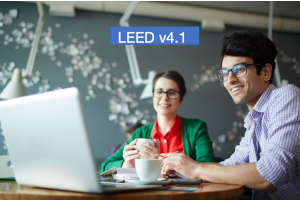How LEED v4.1 Affects Interior Design Projects
- < What is a LEED v4.1 Certification Webinar?
- > Direct Impact: Why Your AIA Course Is Not Increasing Product Specifications
What is LEED v4.1? LEED v4.1 is the most comprehensive, collaborative, accessible and effective LEED system to date. LEED v4.1 improves energy performance, emphasizes human health, and integrative building design. How will LEED v4.1 affect the interior design of projects?
According to a recent article in the USGBC’s online magazine Transforming Our Built Environment, design professionals and manufacturers may benefit from three key Building Product Disclosure and Optimization (BPDO) credits in LEED v4.1. The LEED v4.1 credits are: Environmental Product Declarations (EPDs), Raw Material Extraction, and Material Ingredients.
Environmental Product Declarations (EPDs) In LEED v4.1
Environmental Product Declarations (EPDs) have been one of the major buzzwords in the AEC industry for many years since the launch of LEED v4. Many building product manufacturers have struggled to create EPDs due to cost, complexity, and confusion. EPDs are commonly requested by LEED project teams on their materials submission forms. An EPD is a standardized way of communicating the environmental impacts of a product or system. Exploring large scale industrial systems to collect and analyze data can be an overwhelming task for most manufacturers.
The good news is that Under LEED v4.1, the optimization option for EPDs requires either 10 percent of products by cost or 10 products from three different manufacturers. Additionally, v4.1 gives “bonus” credit for EPDs that are independently verified and third party–certified, giving greater assurance of quality reports. Building product manufacturers who spend the time and money to develop EPDs will hopefully have more opportunities for specification in LEED v4.1.
Sourcing of Raw Materials Credit In LEED v4.1
Revisions were made to the Sourcing of Raw Materials credit. The intent of the credit is “to encourage the use of products and materials for which life cycle information is available and that have environmentally, economically, and socially preferable life cycle impacts. To reward project teams for selecting products verified to have been extracted or sourced in a responsible manner.”
The revisions for Sourcing of Raw Materials credit in LEED v4.1 should allow more manufacturers to participate and help LEED project teams. Option 1 of the credit focuses on a publicly released report from manufacturers about their raw material suppliers which include raw material supplier extraction locations, a commitment to long-term ecologically responsible land use, a commitment to reducing environmental harms from extraction and/or manufacturing processes, and a commitment to meeting applicable standards or programs. In LEED v4.1, products sourced from manufacturers with self-declared reports are valued as one point.
Material Ingredients Credit in LEED v4.1
Building product manufacturers can use a variety of product disclosures to meet Material Ingredients credit. Health Product Declarations (HPDs) have become one of the most requested specification resources for meeting this LEED credit. According to interior designer Annette K. Stelmack, product transparency documentation is important because she works with chemically sensitive clients. “I can quickly go in and know where to find that information—I no longer have to get on the phone with R&D departments because we have more disclosure now,” she says.
Stelmack considers finding product databases to be a first step. Before specifying materials, she researches the manufacturers of products she might specify. Stelmack searches for manufacturers committed to doing life-cycle assessments (LCAs) of their products. With LEED v4.1, she sees a greater access to more sources for a wider selection of products. Stelmack stresses the importance of thinking about interior materials at the beginning of projects. Involve the interior designer early to give us equal opportunity to contribute to the building as a whole. The process begins with researching interior product attributes by digging deep into understanding the composition and chemical make-up of every product,” says Stelmack.
In a previous blog, How LEED v4.1 Could Affect Building Product Manufacturers, we discuss these LEED v4.1 credits in greater detail. How is your company preparing for LEED v4.1? What product transparency documents do you submit for projects?
For more information or to discuss the topic of this blog, please contact Brad Blank





